by pmdavis | Apr 29, 2016
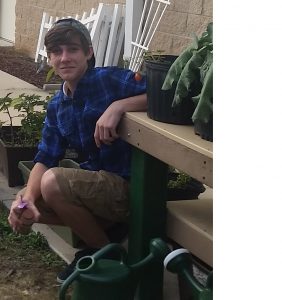 The month of April provides an opportunity to recognize and honor the service of our youngest heroes, military children. Since 1986, April has been designated Month of the Military Child. This allows us to acknowledge the significant role military youth play in our communities and honor them for their commitment and sacrifice. They are resilient and take pride in their service to our Country. They deserve our appreciation and support.
The month of April provides an opportunity to recognize and honor the service of our youngest heroes, military children. Since 1986, April has been designated Month of the Military Child. This allows us to acknowledge the significant role military youth play in our communities and honor them for their commitment and sacrifice. They are resilient and take pride in their service to our Country. They deserve our appreciation and support.
I am so excited to introduce you to one of our 4-H grown military youth, Michael. He began as a Bay County 4-H member as a summer camper three years ago. Michael then became involved with the 4-H club programs on base through the 4-H Torch Leadership Club. He serves as a peer mentor to other military youth in the base school age program. His work with younger youth includes helping them design, plant, and maintain a garden at their youth center. Assisting with homework and school struggles. Michael also participates in the 4-H Archery Program. In February, he was nominated as “Teen of the Month”. At camp this year, he is looking forward to serving as a counselor-in-training. Michael has adopted a quarterly service project using cooking skills he acquired from the 4-H foods and nutrition project to prepare and serve food to the single military members. He and his club are currently perfecting their entrepreneurial skills while working on a service project to support local veterans. He is also on the school track team. Michael is a phenomenal youth with a heart of gold and passion for helping others. He is a well-rounded young man that is very involved in 4-H. He exemplifies the 4 H’s – Head, Hands, Heart and Health. One of his club leaders, Ms. Heather said he really shows an interest in the younger youth and takes his role as a peer mentor seriously. She relayed a story of Michael taking extra time from his schedule to help a youth he was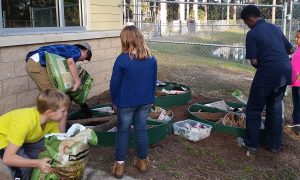 mentoring prepare for an upcoming test. His mentee was struggling to understand the material that was going to be tested on the next day, so extra time was needed reviewing the material.
mentoring prepare for an upcoming test. His mentee was struggling to understand the material that was going to be tested on the next day, so extra time was needed reviewing the material.
When I ask Michael what he felt he was getting out of being a 4-H member at the youth center and at camp, he responded “I feel that for the last few years since I have been in 4-H, I have become more outgoing, confident and experienced in so many ways. If not for 4-H, I might still be sitting in my room all day playing video games. I especially like helping others whenever I can whether it’s at the Youth Center or at Summer Camp. So to me, 4-H is an amazing program that has been a positive influence in my life and in 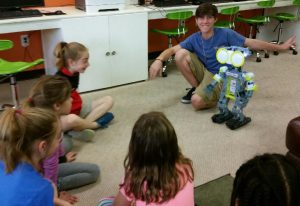 making me the person I am today.”
making me the person I am today.”
If you are a teen and want to learn more about how you can volunteer in your own county, please contact your local extension agent. Volunteering is a time investment that will pay you back exponentially through the growth you see in the youth and program you’re affiliated with. Volunteers come in all forms from peer mentors, camp counselors, to committee members. Follow the links below to see how you can help 4-H expand our capacity to reach more youth, more families, and more communities through utilizing your skills, your knowledge, and your story! #trueleaders #4hgrows
by pmdavis | Feb 5, 2016
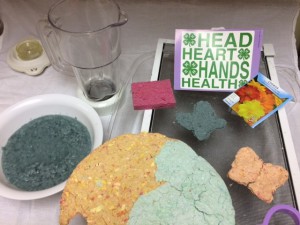
Grow Card Supplies and products
4-H literally got its start with gardening. The very first 4-H Clubs focused on growing tomatoes and corn for boys and canning for girls. Many youth and volunteers still enjoy gardening projects today. One great curricula that is used is the Junior Master Gardening Program. This program allows youth to enhance their life using gardening as the spark of interest. Gardening enriches youth’s lives, promotes good health, gives a sense of environmental awareness and saves money.
One of the activities I enjoy doing with youth combines gardening with recycling and crafting. As a group we will make our own paper grow cards or ornaments that have seeds embedded in them. Once the cards are dry, we deliver them as a service project. The cards are fun and inexpensive to make and are a perfect activity for your next club meeting! Try making them as valentines for Valentines Day. For beginners, we recommend growing tomatoes, lettuce, peppers, cucumbers, basil, chives, or parsley. Not into vegies? Try starting marigolds, cosmos, sunflowers, zinnias, pansies, or petunias.
Download our detailed factsheet with photos and directions. This activity is great for any occasion when you need a card or small gift. You can use as party favors by making them into ornaments using raffia to hang them from a tree or gift bag. You can take them to a nursing home, veterans center, hospital or other site as a service project for your club. Just be sure to share with the individual that they need to plant your card or ornament. It is a great way to help youth share their joy of gardening with others.
Other Extension gardening resources include:
• Florida Vegetable Gardening Guide
If you have a green thumb, consider going “totally green” as a 4-H gardening volunteer! 4-H needs caring adults like you to share their knowledge and passion for gardening with the next generation. Through the 4-H gardening project, youth not only learn gardening knowledge and skills, they also learn responsibility, teamwork, and other life skills that will help them grow up to be compassionate and competent citizens. To get involved, contact your local UF IFAS Extension Office, or visit Florida 4-H.
by Julie Pigott Dillard | Jan 15, 2016
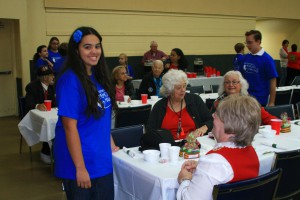
Fire Ants 4-H Club members prepare and serve meals for hospice patients and caregivers to develop compassion and empathy in their community.
There are many genetic traits you’re born with that can’t be changed. But what about traits such as compassion and empathy? Can they be learned? A new study conducted by the University of Wisconsin-Madison shows that adults can indeed be trained to be more compassionate and empathetic. But rather than wait until adulthood to grow this trait, youth involved in 4-H have the opportunity to grow compassion beginning as early as five years old. Giving back has long been one of the essential elements of 4-H programs where youth are given the opportunity to practice service to others.
The Fire Ants 4-H Club is one such club in Washington County that gives its members a chance to practice compassion and giving through its service project with Covenant Hospice. For the past two years, the Fire Ants 4-H Club has partnered with Covenant Hospice to provide volunteer services for its clients.
It began with a few members and parents volunteering to make a meal for a client. Last year, club officers applied for a Florida 4-H Foundation Community Pride grant to grow their efforts with the purpose of providing healthy, home-cooked meals for Hospice clients. Members and parents spent a day preparing and cooking made-from-scratch meals and then portioning them into individual serving containers. Over 100 individual home-cooked meals were frozen and delivered to clients. Members have also served at the past three annual Covenant Hospice banquet that honors patients and caregivers.
Community service has the ability to become life changing not just for those receiving the service but especially for the youth involved. 4-H’ers are learning through hands-on experiences that they can make a difference and that their efforts are important. Getting involved in a cause or effort that matters to youth helps develop skills and experiences that carry over into adult life and cultivate a sense of compassion for the world in which they live. If we grow youth who are more compassionate and empathetic, what does that potentially mean for our world? We are more likely to have youth who are socially responsible, who have a heart for giving back and helping others, who have positive relationships with peers and adults, who have improved communication and critical thinking skills and go into careers that feed their passions and interests.
What will you do in 2016 to grow compassion?
For more information on 4-H clubs in your county, or if you’re an adult who wants to work with youth to help them grow compassion and empathy to make help your community thrive, contact your local UF IFAS County Extension Office or visit http://florida4h.org.
by Jenny Savely | Dec 19, 2015
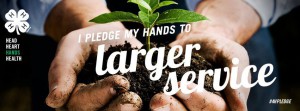
Clear evidence of mastering a skill is being able to employ it in one’s everyday life. Knowledge is only as good as how we are able to use it. 4-H dedicates itself to educating youth with research based curriculum not only for their own benefit but also so they can share that knowledge with others. When we “pledge our hands to larger service”, this can take on many forms. It may look like teaching youth in a community center about robotics or gardening, making meals for the military and first responders, or cleaning up trash in local parks. In all our service, it is important that regardless of what this looks like that we focus on meeting a need in our community. Identifying these needs is sometimes difficult if they are not part of what we see around us regularly. Talking to people who do not have the same life experiences we do is a good way to start seeing the world in a different way and thinking about ways you can help others who haven’t had the same opportunities. In Escambia County, around 30% of our youth population lives in poverty (US Census). Outcomes of living in poverty are hunger, poor housing, poor health, and lower educational scores, just to name a few. Our 4-Hers are learning to use the skills they have gained in 4-H in creative ways to help address some of these issues. One club has received a grant to raise a hog that a youth will show and have processed so the meat can be included in food boxes for local families. Another club raised funds to help support the Council on Aging to provide air conditioning units to the elderly, who are more likely to be impoverished, during the hot summer months.
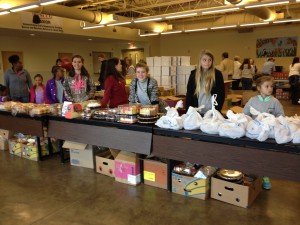
Escambia County 4-Hers assemble food boxes for local families at this year’s Farm to City event.
Whether poverty, pollution, safety, education, healthcare, or another issue is one that effects your community, the skills youth learn through 4-H can help address it. Not only does this help those around us live healthier and more productive lives, but it helps those who serve connect to their community and learn to give back. As with all 4-H projects, our goal is to help youth become more engaged and knowledgeable citizens that contribute to their world in positive ways. We encourage our youth to embody the spirit of generosity all year long, but during this season, be sure to explore the needs in your community you can help to change, even in the smallest way. If you need help thinking of how to best give back, contact your local 4-H Agent, local non-profits, or look up your county’s information in a database such as the US Census’ QuickFacts (http://quickfacts.census.gov/qfd/states/12000.html) and think about what kinds of problems might arise from the information you find there.
4-H also offers many Leadership and Citizenship projects that can help youth navigate assessing the needs of their community and putting their skills to use. You can find a few such project guides at the following links:
If you are interested in helping guide the next generation to be compassionate, active citizens for tomorrow, consider becoming a 4-H Volunteer. 4-H offers a wide variety of roles to fit your interests and schedule. Visit http://florida4h.org or contact your local UF IFAS Extension Office.
US Census. 2015. American Community Survey 2009-2013 five-year estimates, Children Characteristics: Escambia County, FL. Accessed November 18, 2015.

by Melanie Taylor | Dec 11, 2015
 The holidays are often filled with time-honored traditions that include some of our favorite meals and foods. As you celebrate, think of little changes you can make this holiday season to create healthier meals and active days. An added bonus, these small changes may help you to avoid those extra holiday pounds we all fear each year. Happy Cooking!
The holidays are often filled with time-honored traditions that include some of our favorite meals and foods. As you celebrate, think of little changes you can make this holiday season to create healthier meals and active days. An added bonus, these small changes may help you to avoid those extra holiday pounds we all fear each year. Happy Cooking!
In the Kitchen:
• For gravies or sauces — if you are making pan gravy, first skim the fat off pan drippings. For cream or white sauces, use fat-free (skim) milk and soft tub or liquid margarine.
• For dressings or stuffing — add low-sodium broth or pan drippings with the fat skimmed off instead of lard or butter. Use herbs and spices and a whole grain bread for added flavor.
• For biscuits — use vegetable oil instead of lard or butter and fat-free (skim) milk or 1 percent buttermilk instead of regular milk.
• For greens — use skin-free smoked turkey, liquid smoke, fat-free bacon bits, or low-fat bacon instead of fatty meats.
• For sweet potato pie — mash sweet potato with orange juice concentrate, nutmeg, vanilla, cinnamon, and only one egg. Leave out the butter.
• For cakes, cookies, quick breads, and pancakes — use egg whites or egg substitute instead of whole eggs. Two egg whites can be substituted in many recipes for one whole egg.
• Use unsweetened applesauce or mashed ripe bananas instead of butter.
• Try cutting the amount of sugar listed in recipes in half.
• Use spices to add flavor such as cinnamon, allspice, or nutmeg instead of salt.
• Try baked apples with cinnamon and a sprinkle of sugar instead of apple pie.
• Invite your guests to make their own parfait with colorful sliced fruit and low-fat yogurt.
For meats and poultry (chicken and turkey):
• Trim away all of the visible fat from meats and poultry before cooking.
• Take off poultry skin before eating.
• Broil, grill, roast, poach, or boil meat, poultry, or fish instead of frying.
• Drain off any fat that appears during cooking.
• Chill meat and poultry broth until fat becomes solid. Skim off fat before using the broth.
• Skip or limit the breading on meat, poultry, or fish. Breading adds fat and calories. It will also cause the food to soak up more fat during frying.
• Choose and prepare foods without high fat sauces or gravies.
When Shopping:
• Start with a lean choice.
• The leanest beef cuts include round steaks and roasts (round eye, top round, bottom round, round tip), top loin, top sirloin, and chuck shoulder and arm roasts.
• The leanest pork choices include pork loin, tenderloin, center loin, and ham.
• Boneless skinless chicken breasts and turkey cutlets are the leanest poultry choice.
Use the food label to help you choose
• Choose extra lean ground beef. The label should say at least “90% lean.” You may be able to find ground beef that is 93% or 95% lean.
• Processed meats such as hams, sausages, frankfurters, and luncheon or deli meats have added sodium. Check the ingredient and Nutrition Facts label to help limit sodium intake.
• Fresh chicken, turkey, and pork that have been enhanced with a salt-containing solution also have added sodium. Check the product label for statements such as “self-basting” or “contains up to __% of __.”
• Lower fat versions of many processed meats are available. Look on the Nutrition Facts label to choose products with less fat and saturated fat.
De-Saturate
• Use a nonstick pan with vegetable cooking oil spray or a small amount of liquid vegetable oil instead of lard, butter, shortening, or other fats that are solid at room temperature.
Enjoy the Food, Fun, Friends and Family!
Cheers to Good Health
• Quench your thirst with low-calorie options. Drink water with lemon or lime slices. Offer seltzer water with a splash of 100% fruit juice.
Be the Life of the Party
• Laugh, mingle, dance, and play games. Focus on fun and enjoy the company of others.
Give to Others
• Spend time providing foods or preparing meals for those who may need a little help. Give food to a local food bank or volunteer to serve meals at a shelter during the holiday season. Giving back is a great mood booster.
Make Exercise a Part of the Fun
• Make being active part of your holiday tradition. Have fun walking and talking with family and friends after a holiday meal. Give gifts that encourage others to practice healthy habits such as workout DVDs, running shoes, and reusable water bottles.
Enjoy the Leftovers
• Create delicious new meals with your leftovers. Add turkey to soups or salads. Use extra veggies in omelets, sandwiches, or stews. The possibilities are endless!
Be sure your family and friends enjoy the food and fun, but focus on the time together. Remember this season is all about the memories, not just the food. You will feel better and enjoy your holiday time with less worry if you focus on staying healthy this season.
Source: USDA United States Department of Agriculture – www.MyPlate.gov
 The month of April provides an opportunity to recognize and honor the service of our youngest heroes, military children. Since 1986, April has been designated Month of the Military Child. This allows us to acknowledge the significant role military youth play in our communities and honor them for their commitment and sacrifice. They are resilient and take pride in their service to our Country. They deserve our appreciation and support.
The month of April provides an opportunity to recognize and honor the service of our youngest heroes, military children. Since 1986, April has been designated Month of the Military Child. This allows us to acknowledge the significant role military youth play in our communities and honor them for their commitment and sacrifice. They are resilient and take pride in their service to our Country. They deserve our appreciation and support. mentoring prepare for an upcoming test. His mentee was struggling to understand the material that was going to be tested on the next day, so extra time was needed reviewing the material.
mentoring prepare for an upcoming test. His mentee was struggling to understand the material that was going to be tested on the next day, so extra time was needed reviewing the material. making me the person I am today.”
making me the person I am today.”




